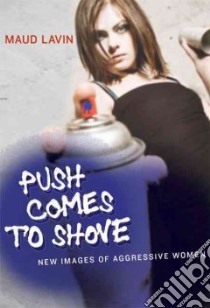- Libreria
- >
- Libri in lingua
- >
Push Comes to Shove - 9780262123099
Un libro in lingua di Maud Lavin edito da Mit Pr, 2010
- € 6.80
- Il prezzo è variabile in funzione del cambio della valuta d’origine
"In investigating the nuances of feminine aggression and its various forms of expression both historically and in contemporary culture, Maud Lavin also documents how we can understand it as a deeply productive and often necessary drive. Better yet, with her characteristic energy and invention, she imagines it as a force at once creative, comedic, erotic---which is to say, one that is not restricting, but rather, both enriching and exhilarating." Akiko Busch, author of Nine Ways to Cross a River
"Push Comes to Shove is eloquent and inspiring. Simultaneously realistic and hopeful about the place and reception of strong women in contemporary society, this is an important book for all researchers on women and girls, and will be of interest to general audiences as well." Leslie Heywood, author of Pretty Good for a Girl and Built to Win
"In Push Comes to Shove, Maud Lavin puts to words a motivational truth for brave women everywhere---if we sit around and wait to be given what is rightfully ours, then we will sit around and wait forever. Sometimes we just have to grab it and not look back." Keala Kennelly, big wave surfer and the first woman to tow-in surf at Teahupo'o in Tahiti
In the past, more often than not, aggressive women have been rebuked, told to keep a lid on, turn the other cheek, get over it. Repression more than aggression was seen as woman's domain. But recently there's been a noticeable cultural shift. With growing frequency, women's aggression is now celebrated in contemporary culture---in movies and TV, online ventures, and art. In Push Comes to Shove, Maud Lavin examines these new images of aggressive women and how they affect women's lives.
Aggression, says Lavin, is necessary, large, messy, psychological, and physical. Aggression need not entail causing harm to another; we can think of it as the use of force to create change---fruitful, destructive, or both. And over the past twenty years, contemporary culture has shown women seizing this power. Lavin chooses provocative examples to explore the complexity of aggression: the surfer girls in Blue Crush; Helen Mirren as Jane Tennison in Prime Suspect; the homicidal women in Kill Bill and artist Marlene McCarty's mural-sized Murder Girls; the erotica of Zane and the art of Kara Walker; the group dynamics of artists (including the artists group Toxic Titties) and activists; and YouTube videos of a woman boxer training and fighting.
Women need aggression and need to use it consciously, Lavin writes. With Push Comes to Shove, she explores the crucial questions of how to manifest aggression, how to represent it, and how to keep open a cultural space for it.
Informazioni bibliografiche
- Titolo del Libro in lingua: Push Comes to Shove
- Sottotitolo: New Images of Aggressive Women
- Autore: Maud Lavin
- Editore: Mit Pr
- Collana: Mit Pr (Hardcover)
- Data di Pubblicazione: 20 Agosto '10
- Genere: ART
- Argomenti : Women in art Women in popular culture United States History 20th century Women in popular culture United States History 21st century
- Pagine: 300
- ISBN-10: 0262123096
- EAN-13: 9780262123099


